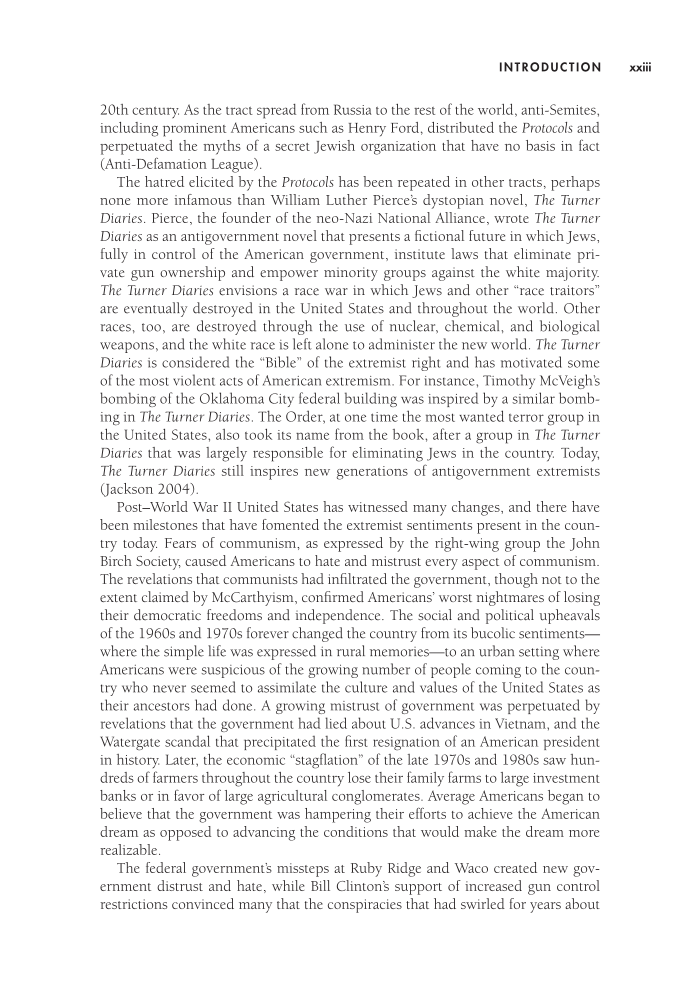xxiii INTRODUCTION 20th century. As the tract spread from Russia to the rest of the world, anti-Semites, including prominent Americans such as Henry Ford, distributed the Protocols and perpetuated the myths of a secret Jewish organization that have no basis in fact (Anti-Defamation League). The hatred elicited by the Protocols has been repeated in other tracts, perhaps none more infamous than William Luther Pierce’s dystopian novel, The Turner Diaries. Pierce, the founder of the neo-Nazi National Alliance, wrote The Turner Diaries as an antigovernment novel that presents a fictional future in which Jews, fully in control of the American government, institute laws that eliminate pri- vate gun ownership and empower minority groups against the white majority. The Turner Diaries envisions a race war in which Jews and other “race traitors” are eventually destroyed in the United States and throughout the world. Other races, too, are destroyed through the use of nuclear, chemical, and biological weapons, and the white race is left alone to administer the new world. The Turner Diaries is considered the “Bible” of the extremist right and has motivated some of the most violent acts of American extremism. For instance, Timothy McVeigh’s bombing of the Oklahoma City federal building was inspired by a similar bomb- ing in The Turner Diaries. The Order, at one time the most wanted terror group in the United States, also took its name from the book, after a group in The Turner Diaries that was largely responsible for eliminating Jews in the country. Today, The Turner Diaries still inspires new generations of antigovernment extremists (Jackson 2004). Post–World War II United States has witnessed many changes, and there have been milestones that have fomented the extremist sentiments present in the coun- try today. Fears of communism, as expressed by the right-wing group the John Birch Society, caused Americans to hate and mistrust every aspect of communism. The revelations that communists had infiltrated the government, though not to the extent claimed by McCarthyism, confirmed Americans’ worst nightmares of losing their democratic freedoms and independence. The social and political upheavals of the 1960s and 1970s forever changed the country from its bucolic sentiments— where the simple life was expressed in rural memories—to an urban setting where Americans were suspicious of the growing number of people coming to the coun- try who never seemed to assimilate the culture and values of the United States as their ancestors had done. A growing mistrust of government was perpetuated by revelations that the government had lied about U.S. advances in Vietnam, and the Watergate scandal that precipitated the first resignation of an American president in history. Later, the economic “stagflation” of the late 1970s and 1980s saw hun- dreds of farmers throughout the country lose their family farms to large investment banks or in favor of large agricultural conglomerates. Average Americans began to believe that the government was hampering their efforts to achieve the American dream as opposed to advancing the conditions that would make the dream more realizable. The federal government’s missteps at Ruby Ridge and Waco created new gov- ernment distrust and hate, while Bill Clinton’s support of increased gun control restrictions convinced many that the conspiracies that had swirled for years about
Document Details My Account Print multiple pages
Print
You have printed 0 times in the last 24 hours.
Your print count will reset on at .
You may print 0 more time(s) before then.
You may print a maximum of 0 pages at a time.


















































































































































































































































































































































































































































































